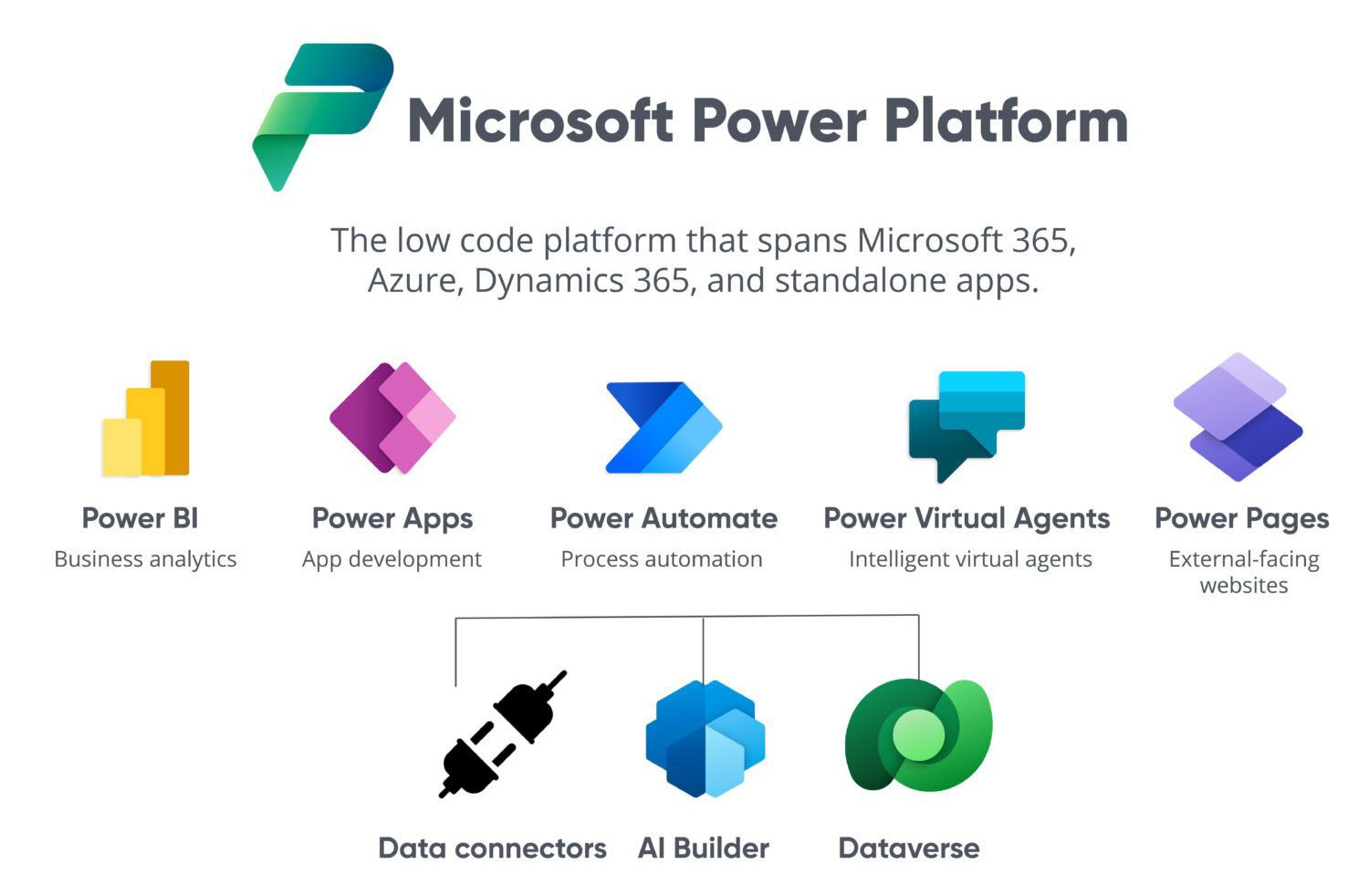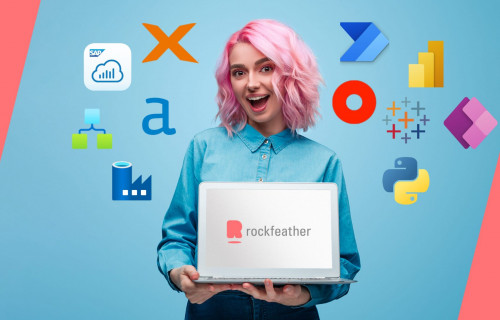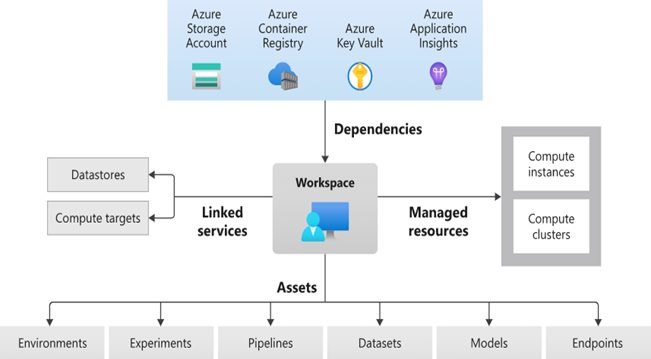
The Power of Microsofts Low Code platform
As the low-code platform that integrates with Microsoft 365, Azure, and Dynamics 365, the Microsoft Power Platform is perfect for professionals who want to develop apps but lack the necessary programming knowledge. In addition, because of its integration with other Microsoft platforms, the Power Platform is perfect for companies that use Microsoft tools. But what are the different apps? And why is using the Power Platform so useful? What's so convenient about Low Code? In this blog, we try to answer all these questions.
What are power apps?
To put it in Microsoft’s words: “Power Apps is a suite of apps, services, and connectors, as well as a data platform, that provides a rapid development environment to build custom apps for your business needs.”
Power Apps enables you (an accountant, engineer, chef, CEO) to build applications that solve your problems regardless of their size.
What is low-code?
Low-code is a way to build applications quickly in a “drag and drop” environment. Low-code enables anyone with a desire to build apps quickly and create something without having to understand coding languages like Java or C++.
On top of that, Low-code also enables you to connect to a variety of back-ends or third party services without having to manually connect to an API or other complex connection tools.
What can low-code offer me?
- Automation
- Re-usability
- Scalability
- Rapid development
- Cross-platform applications
What are the low-code apps within the Microsoft Stack?
Power Apps
The bread and butter of the low-code Power Platform. It enables you to create applications that display data and allow you to interact with your data directly. Power Apps enables you to build applications for both Mobile and web by using a drag and drop interface.
Power Automate
If you want to create automated processes running in the background, this is how you do it. If you want to send emails after new records are created, while at the same time notifying users, Power Automate does this with just a few clicks.
Power Virtual Agents
One of Microsoft’s newest offerings allows you to create chat bots using a low-code approach. Chat bots can be deployed internally on Teams or on your own website. They enable users or customers to find answers to problems without the need for a human-ran support centre.
Power BI
With Power BI, you get even more out of Business Intelligence. Create stunning visuals that provide deep insights into your data and financials. Use forecasting to better predict changes in upcoming time periods and adjust your business planning accordingly.
Power Platform use cases
Imagine you’re an accountant that has to modify data in excel based on the parameters that someone emails to you on a daily basis. Based on these emails, you want to have an overview of all of your data to be able to show to management during your monthly meetings and, on top of this, you want to be able to modify something within the data on a last minute basis if needed. The Power Platform and it’s low code tools can help you automate a large part of your workflow. Here is how:
- We’ll use Power Automate to scrape the values from the email and modify the excel sheet.
- Once the sheet is modified, we can create a dashboard to have a full overview using Power BI to present at your monthly meetings.
- And lastly, we use Power Apps to create a small app that you can modify your data from, if case last-minute modifications are needed.
- Lastly, we could create a Virtual Agent to enable colleagues or clients to request copies of documents from a certain case file using a specified password.
Benefits of Low-code
- Save time and money
- No need to hire a full stack developer
- Custom solutions for custom problems
- Easy to implement
Rockfeather & Low-code
Here at Rockfeather, we know that not everyone has the budget for their business ideas to become reality. That’s why we offer both trainings in low-code as well as building services. We empower everyone to become a citizen developer – this enables you to build things in your own time, with your own tools. If you get stuck or need help, you can be sure that Rockfeather will be there to lend a hand.
For the more advanced projects, we use all of the tools above and more to create fully fledged desktop and mobile applications that can be exported and deployed to your environment seamlessly.
More blogs

Webinar: Advanced forecasting with data science
Forecasting with Data Science can help your organization take the next step in data maturity. In this webinar, we’ll show you how to get even more out of your forecasts with AI.

Power Automate or Logic Apps
Power Automate or Logic apps? Two similar automation tools, both on the Microsoft platform with a common look. With many of the same features the differentiation lies in the details.

Looking back: Data & Analytics Line Up 2022
Want to know what’s on sale for dashboarding or data integration solutions? Want to compare data science solutions? Or would you like to see Low Coding platforms in action? This and more was discussed at the Data & Analytics Line Up 2022!

Power Automate or Logic Apps
Power Automate or Logic apps? Two similar automation tools, both on the Microsoft platform with a common look. With many of the same features the differentiation lies in the details.
Comparing features
Most notably, Logic Apps is aimed at more technically proficient users. Power automate is really aimed at citizen developers, however, with less in-depth features and more user-friendly options.
For most companies, Power Automate is included in the Microsoft Office license with the standard connectors. Though, customers interested in premium connectors will need a premium license. Logic Apps is a service that’s pay as you go, meaning that you pay while the app is running.
Below are 3 key differences:
- Power Automate integrates well with the Power Platform, whereas Logic Apps integrates with azure resources
- Logic Apps supports version control
- Power automate supports robotic process automation
To further expand on the differences in licensing between Power Automate and Logic Apps, we summarized some key takeaways below:
- Logic apps: Pay as you go. You only pay when your application is actively running
- Power Automate: Pay per Month. You pay a fixed fee per user per month, and it’s often already included in your Microsoft Office license (E1, E3 and E5)
Important details
Power automate is part of the Microsoft 365 environment and the power platform, and its main aim is to automate tasks and work within the Power Platform. By comparison, Logic Apps is one of the solutions within the Microsoft Azure Integration Services and is thus more commonly used for ETL processes and data integration. Therefore, Logic Apps has good integration within Azure, but lacks this integration with the Power Platform. What’s best for your business simply depends on what type of capability you need and what you want.
For instance, consider the following examples:
- A manager wants to get an email when a certain KPI value is reached, this KPI is calculated and presented in Power BI, depending on circumstances this could both be done by Power Automate or Logic apps
- A finance employee needs to click a few buttons in a legacy application on his desktop once a day. With Power Automate RPA, this can be automated.
- Data needs to be extracted from a system and loaded to a data warehouse, for this, process Logic App provides the best pricing and the most flexibility.
- A monthly survey needs to be sent out, this is best done via Power Automate
- A process must be approved through a button on a dashboard, because of the Power Platform functionality here Power Automate is best
Compare for yourself
Interested about the strengths and weaknesses of both platforms? We have articles that dive deeper into both Logic Apps and Power Automate and all their pros and cons.

Artificial Intelligence is ready!
In this interview, Jonathan Aardema talks with Prof. Eric Postma (professor of Cognitive Science and Artificial Intelligence at the University of Tilburg) about the why, how, and what of artificial intelligence applications. What do we see in practice, and what does science say about it?

Visiting London for the Tableau Partner Executive Kick-Off 2020
Every year Tableau invites its most valuable partners to kick off the new year together. The theme for this year was Accelerate, so let’s get right to the point. This exciting event was focused on three main areas.

Mastering DAX
Keeping your skills up to date is crucial when you work with the newest technology. At Rockfeather, we challenge each other to be the best version of yourself. That’s why I attended the mastering DAX course. DAX (Data Analysis Expressions) is a formula expression language. Next to Power BI, DAX is applied in Excel Power Pivot and tabular models in SQL Server. Learn it once, use it tomorrow.

Microsoft’s Cloud based machine learning service
• Notebooks
• Auto ML
• A drag & drop tool called Designer
Machine learning in a nutshell
Machine learning is a form of artificial intelligence where, through software and algorithms a computer uses from historical data to make predictions about the future. These complex computer codes, also known as algorithms, are used to create complex models. These machine learning models use algorithms to find patterns or relationships in the data, which can then be used by a model to predict values based on new data.
What is Azure Machine Learning?
Azure Machine Learning is Microsoft’s answer to the increasing demand for Machine Learning as a Service solutions. With Azure Machine Learning, Microsoft provides a cloud based machine learning environment within the Azure platform through which data science projects can be run and managed. The machine learning services seamlessly integrate with the other cloud computing services Microsoft offers through the Azure platform. Azure Machine Learning gives you the ability to develop models based on open source machine learning tools such as Pytoch, TensorFlow, scikit-learn and many other resources.

What does Azure Machine Learning Workspace offer?
- Auto ML
- A drag and drop interface for citizen data scientists called Designer
- Scalability of computing power and data storage
- Integration with the Azure platform
- Wide variety of algorithms for different machine learning purposes
- You can easily convert your machine learning model to a web service
- Version management per model
The different features of Azure Machine Learning
- Notebooks
In the machine learning workspace, you can create a notebook that works similar to a Jupyter Notebook. Jupyter Notebooks have been used for years to develop code for data science projects. In a notebook, pieces of code can be written in cells to manipulate data and train a model. - Automated ML
If you have structured and clean data, then you can use Auto ML. With Auto ML, you enter the data step by step while going through a menu where you can determine various settings. For example, you indicate what value you want to predict with your model and what error metric should be used to compare the different models. When the set-up is done, Auto ML starts training and testing models. After this process, you will be presented with the best model. Running Auto ML for simple use cases works well through the menu interface, but when things get more complicated you will need to run Auto ML from a notebook. - Designer
Designer is the drag and drop interface of Azure Machine Learning. This component can be compared to the way a machine learning project can be built in an intuitive way in Alteryx. In the designer canvas, so called pipelines can be created where you can visually lay out the data from the raw input to the trained model.
Use-case for Auto ML: Training multiple models
A major development in the field of data science in recent years has been the emergence of Auto ML. This development automates parts of the data science development process that were previously often repetitive and time-consuming. In fact, the most modern Auto ML solutions can perform almost the entire development process with well-structured data. However, in most cases, data is not so structured and prior work is still needed. Big data needs to be trained before it can be used in a model. Where Auto ML really adds great value is in training and testing different models. Previously, after cleaning and structuring big data, the data scientist had to determine which models to train and test. The process of training and testing different models is a time-consuming task and often requires a lot of computing power. This is one of the reasons why data scientists often choose to train and test only a limited selection of algorithms. Auto ML allows the data scientist to train and test a much larger selection of algorithms on scalable cloud computers. In this way, the data scientist does not have to train and test every algorithm himself. With Auto ML, the data scientist indicates which algorithms should be tested and trained and which ones should be compared according to which error metric and/or statistics results. As an analogy, think of it like cycling. Previously, a data scientist cycled around on a city bike without gears, but with the development of Auto ML, a data scientist gets an electric bike with pedal assistance. You still have to ride the bike, but there is support from technology that gets data scientists to their destination faster.
Benefits of Microsoft Azure Machine Learning
- Scalability
- Clear documentation.
- Easy to implement
- Integration with Microsoft’s Azure platform
- ML as a service
Rockfeather & Azure Machine Learning
At Rockfeather, we are also aware of the advantages that Azure Machine Learning offers over conventional data science tools. Using Azure Machine Learning allows us to deliver better and faster results to our customers in the field of data science. One of the projects where we at Rockfeather have leveraged Azure Machine Learning effectively is predicting sales numbers for one of our clients. These predictions, or forecasts as it is officially called, is a branch of data science that uses historical data to make predictions about the future. Good forecasting is important to this client because it saves costs and waste. The challenge with this project was that there was a large assortment of different products and therefore sales numbers had to be predicted for all these products. Manually training and testing models for a large assortment takes a lot of time, which is why we applied Auto ML in this situation. Because of the scalability of Azure’s cloud based Machine Learning, we can train and test a selection of different algorithms per product to find the most effective algorithm for each product. These models are all stored in Azure Machine Learning and once trained can be used to actually make predictions about future sales numbers.

Artificial Intelligence is ready!
In this interview, Jonathan Aardema talks with Prof. Eric Postma (professor of Cognitive Science and Artificial Intelligence at the University of Tilburg) about the why, how, and what of artificial intelligence applications. What do we see in practice, and what does science say about it?

Visiting London for the Tableau Partner Executive Kick-Off 2020
Every year Tableau invites its most valuable partners to kick off the new year together. The theme for this year was Accelerate, so let’s get right to the point. This exciting event was focused on three main areas.

Mastering DAX
Keeping your skills up to date is crucial when you work with the newest technology. At Rockfeather, we challenge each other to be the best version of yourself. That’s why I attended the mastering DAX course. DAX (Data Analysis Expressions) is a formula expression language. Next to Power BI, DAX is applied in Excel Power Pivot and tabular models in SQL Server. Learn it once, use it tomorrow.


